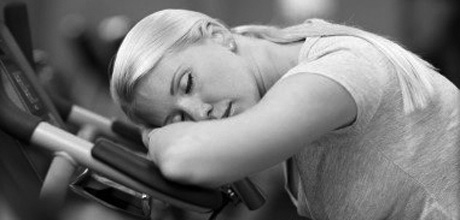A common mistake of people new to exercising – and even among experienced exercisers – is to workout too hard, too often. Overtraining can effect your health. By not allowing for proper rest periods in your workout routine, it is far more likely that you don’t adhere to your exercise habit, due to feeling poorly, excess fatigue or soreness, or even injury, if you aren’t allowing your body to heal in between workouts.
So how many rest days do you really need a week?
The number of rest days that you take each week depends on how intensely you train, especially relative to your fitness level. As a rule, if a muscle group is still sore from a previous workout, do not train it intensely again until it has healed and is no longer sore.
For example, if my thighs are sore from a lower body strength workout I did yesterday, I should not train them again today – or the next, if they are still very sore. In this case, it doesn’t mean I have to take a complete rest day; I could train my upper body or core, or stick to light cardio, yoga, stretching, etc.
Balancing your workouts to target different muscle groups on different days of the week allows you to take fewer rest days, but even then, you should save at least 1-2 days a week for rest, or at least active rest or active recovery.
What is active rest or active recovery?
You don’t have to spend your whole ‘rest day’ on the sofa! Light physical activity on a rest day can help boost your mood, your health, and your progress or ability to maintain your weight or fitness level.
If you’re looking to stay active even on your rest days, a good rule is that the activity should not be something that would cause you sore muscles. Whether you’re walking, swimming, doing yoga, stretching, etc, it should be at a reduced intensity from your normal workouts.
What happens if I over-exercise?
If you don’t include enough rest into your workout programme, you are putting yourself at risk for overtraining, which increases your chances of health repercussions and otherwise avoidable injuries.
The best thing you can do is to listen to your own body; if you think it might be asking for more rest, don’t think that listening to that request means that you’re a failure or ‘slacking’. Rest is an important part of fitness and can be what makes the hard work you put towards your goals count.
Overtraining symptoms are diverse and different for each person, but here are a few symptoms you should watch out for:
- Depression
- Loss of appetite
- Severe fatigue
- Slower healing & longer recovery times
- Changes in mood and ability to focus or concentrate
- Amenorrhea – missed or very irregular periods
- Aches & pains – particularly of the joints
- Depressed immune system – increased chance of catching colds and other infections
- Changes in performance – if you find yourself moving slower, lifting less than you’re normally able to, having to take more rest breaks and generally not pushing yourself as hard as you normally do, you could be overtraining.


